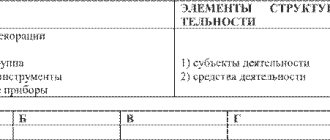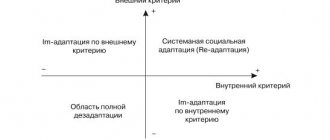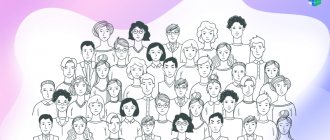The world around us is perceived by a person through his psyche, which forms individual consciousness. It includes the totality of all the individual’s knowledge about the reality around him. It is formed through the process of understanding the world through its perception with the help of 5 senses.
Receiving information from the outside, the human brain remembers it and subsequently uses it to recreate a picture of the world. This happens when an individual, based on the information received, uses thinking, memory or imagination.
Concept of consciousness
With the help of consciousness, a person not only contrasts his “I” with what surrounds him, but is also able to restore pictures of the past with the help of memory, and imagination helps him create what is not yet in his life. At the same time, thinking helps to solve problems that reality poses to an individual on the basis of knowledge gained from its perception. If any of these elements of consciousness are disrupted, the psyche will suffer serious trauma.
Thus, individual consciousness is the highest degree of a person’s mental perception of the reality around him, in which his subjective picture of the world is formed.
In philosophy, consciousness is always opposed to matter. In ancient times, this was the name for a substance capable of creating reality. This concept in this understanding was first introduced by Plato in his treatises, and then it formed the basis of the Christian religion and philosophy of the Middle Ages.
Ancestral memory and “dejavu”
It is known that another 3. Freud wrote about the inheritance of “ancestral memory”. He believed that the memory of centuries is stored in the subconscious areas of our brain.
At the same time, in his constructions concerning the laws of human mental activity, Freud assumed the possibility of transmitting individual events of this “ancestral memory” through genetic mechanisms.
So, he believed that each of us in the deep areas of the brain has a subconscious memory, say, for such events as the murder in the distant past by our wild ancestor of his father, facts of incest, etc.
It is this “guilt” for what our distant ancestors committed in the past, which has planted itself, like a splinter, in the subconscious sphere of each of the living people, and is supposedly the basis, the cause of many cases of neuroses.
Such “revelations” of 3. Freud are completely rejected by the data of modern neurophysiology. Genetically, “ancestral memory” can transmit only some of the most general features of a person’s higher nervous activity, which determine the degree of his excitability, reactivity, temperament, character, but not the memory of events that happened in an individual’s life.
Therefore, it cannot be what I. Efremov so colorfully described in his novel “The Razor’s Edge”: the reconstruction in the memory of a modern person of events that happened to some distant ancestor.
It is interesting that the wonderful Russian writer I. Bunin was confident that his memory stored memories of certain events passed down to him from his ancestors and, in particular, from his father. You can read about this, for example, in Sergei Antonov’s book “From the First Person”.
In “The Life of Arsenyev” I. Bunin writes: “Could we love the world the way we love it, if it were completely new to us?” And, having arrived in Sevastopol for the first time, he was sure that he had already seen this city before (his father fought in Sevastopol).
All this is well known in medicine under the name of the phenomenon of “already seen” (“dejavu”). Initially, it was described in patients with damage to the temporal region of the brain (due to tumor, epilepsy, etc.).
In this area of the brain there are structures that seem to “authorize” recognition, the similarity of a given phenomenon with some previous one. And in the case of a disease, these structures can “work” even in the absence of actual similarity, causing “false recognition.”
It is interesting that painful processes in this area can also cause the opposite phenomenon, when a well-known situation will seem to the patient to be seen for the first time (the “jamaisvu” phenomenon).
The phenomenon of “already seen” is sometimes observed in healthy people. According to some scientists, this happens more often in people who have studied for a long time or have traveled a lot. Similar cases are described in fiction (for example, by Dickens in “David Copperfield”). Apparently, Bunin’s psyche also possessed this rather rare feature.
Since, as has already been said, individual consciousness is formed anew each time in the process of interaction of the brain with external factors, it should be clear that any elements of individual consciousness cannot be transmitted from parents to children. Actually, this was well said by Lucretius: “And therefore we must make sure that the former souls perished, and the one that now exists was now born.”
Consciousness and matter
Materialists have narrowed the functions of consciousness to the property of an entity that cannot exist outside the human body, thereby putting matter in first place. Their theory that individual consciousness is matter generated exclusively by the human brain has no basis. This can be seen in the contrast of their qualities. Consciousness has no taste, no color, no smell, it cannot be touched or given any form.
But it is also impossible to accept the theory of idealists that consciousness is an independent substance in relation to a person. This is refuted by the chemical and physical processes that occur in the brain when an individual perceives the surrounding reality.
Thus, scientists have come to the conclusion that consciousness is the highest form of the psyche, reflecting existence, which has the ability to influence and transform reality.
Where does consciousness live?
Where is consciousness localized in the human brain? Is there any limited area responsible for this function?
It is known that complex mental functions such as speech, writing, and counting are impaired when certain areas of the cerebral cortex are damaged.
This gave rise to the identification of speech, writing, and counting centers in it. Later, however, it became clear that in these cases it is only possible to talk about “centers” as limited areas where exactly this function is embedded.
The fact is that these “centers” are located at the junctions of those areas of the brain where the nerve pathways from various sense organs end and which themselves, thus, are indeed the highest cortical analyzers for such relatively simple functions as hearing, vision, touch, etc. d.
For the formation of such complex skills as speech, writing, and counting, it turns out that it is necessary to form special connections between these cortical zones. That is why the junctions of these zones seem to be like centers of speech, writing, etc., because their destruction actually leads to a person’s loss of these functions.
Attempts to isolate and localize an even more complex function of the brain—the function of consciousness—in very specific areas have been known for a long time. Once in ancient times, R. Descartes arbitrarily chose as the seat of consciousness a small formation in the brain called the pineal gland for its shape, which was indeed somewhat similar to a Christmas tree cone.
Due to the fact that consciousness is switched off when the brain stem is damaged, in recent decades it has been considered that the brain stem formations are the center of consciousness. And more recently, quite widespread in the West was the hypothesis about the centrencephalic system as a kind of center of consciousness, proposed by the famous Canadian neurophysiologist V. Penfield (by the way, the author of the novel “Torch” about the life of the greatest physician of antiquity, Hippocrates).
But all these theories do not take into account what has already been said, namely, that a violation of any complex function of the brain, for example, loss of speech when one or another area is damaged, does not yet mean that this particular affected area is the “center” this function.
Indeed, such a complex phenomenon as consciousness is formed as a result of the work of the most diverse levels and areas of the brain. For example, its trunk structures maintain the function of consciousness at the level of wakefulness: in the trunk there are paths that, like a power plant, energetically feed the overlying parts of the brain.
Naturally, when this power plant is turned off, the “light bulb cells” in the cerebral cortex go out. Although consciousness is a multi-layered and multi-linked structure, it is basically still a function of the cerebral cortex, depending on the joint synchronous work of many cortical zones. Therefore, damage to any part of the cortex, “breakdown” of any of its complex activities - such as speech, writing - leads to a certain impairment of consciousness, although it does not turn it off completely.
Despite the fact that today we know a lot about the functioning of the brain as a whole and its individual structures, we must still admit that we are still very far from fully understanding all the physiological foundations of this wonderful phenomenon - individual consciousness. Perhaps the measures with which modern science approaches its explanation are insufficient and not entirely adequate.
For example, in physics: at some stage of its development, the obvious provisions and principles of Newtonian physics turned out to be insufficient to explain the facts obtained, and completely new ideas were needed, new theories developed by the brilliant Einstein, Bohr, Planck and others.
The fact that the explanation of each new higher level of phenomena also requires new approaches, new theories is evidenced by the methodological requirements of the principle of complementarity put forward by Niels Bohr, as well as the general theory of systems developed in the works of L. Bertalanffy. According to the latter, the patterns of activity of a particular system cannot be reduced only to the patterns characteristic of the subsystems included in it.
Attempts to find these new approaches, new ways to explain the phenomenon of individual consciousness have been made before, and are still being made today. And one should not fall into pessimism; one should not think, following the skeptics, that this problem is insoluble.
Already, much of the problem of neurophysiological mechanisms underlying individual consciousness has become clear to us, although, undoubtedly, even more will need to be done in order to fully understand the essence of this amazing phenomenon.
Components of consciousness
When describing its structure, it should be taken into account that it is two-dimensional:
- On the one hand, it contains all the collected information about external reality and the objects that fill it.
- On the other hand, it also contains information about the individual himself, who is the bearer of consciousness, which, with development, passes into the category of self-consciousness.
Individual consciousness forms a picture of the world, which includes not only external objects, but also the person himself with his thoughts, feelings, needs and actions to realize them.
Without the process of self-knowledge, there would be no human development in the social, professional, moral and physical spheres, which would not lead to an awareness of the meaning of one’s own life.
Consciousness consists of several blocks, the main ones of which are:
- The processes of knowing the world through the senses, as well as its perception through sensations, thinking, speech, language and memory.
- Emotions that convey the subject’s positive, neutral or negative attitude towards reality.
- Processes associated with making and executing decisions and volitional efforts.
All blocks together provide both the formation of a person’s certain knowledge about reality and satisfy all his urgent needs.
Bibliography
- Philosophy, textbook // Ed. Lavrinenko V.V. - M.: 2004;
- Philosophy, textbook for university students // ed. V.P. Kokhanovsky - Rostov n/a: 1998;
- Alekseev P.V., Panin A.V. Philosophy, textbook. M. - 2003;
- Kuznetsov V.G., Kuznetsova I.D., Mironov V.V., Momdzhyan K.Kh. Philosophy, textbook. M.: 2004;
- modern philosophy: dictionary and reading notes;
- Smirnov I., Titov V. Philosophy, textbook.-Moscow: 2004;
- Spirkin A.G. Philosophy, textbook, M.: 2006;
- Balashov L.E. Philosophy, textbook-M.: 2005;
- Alekseev P.V., Panin A.V. Epistemology and dialectics. M.: 1991.
- Barulin V.S. Fundamentals of socio-philosophical anthropology. - M.: 2002.
.
Social consciousness
In philosophy and psychology there is such a concept as the relationship between social and individual consciousness. It should be taken into account that the social is a product of individual or collective concepts that were formed over a long period of observation of reality, its objects and ongoing phenomena.
The very first forms of social consciousness formed in human society were religion, morality, art, philosophy, science and others. For example, observing natural elements, people attributed their manifestations to the will of the gods, creating public knowledge about these phenomena through individual conclusions and fears. Collected together, they were passed on to subsequent generations as the only truth about the surrounding world inherent in a given society. This is how religion was born. People belonging to other nations with opposite social consciousness were considered infidels.
Thus, societies were formed, the majority of whose members adhered to generally accepted principles. People in such an organization are united by common traditions, language, religion, legal and ethical standards, and much more.
To understand how social and individual consciousness are interconnected, you should know that it is the second that is primary. The consciousness of one member of society can influence the formation or change of the social, for example, as was the case with the ideas of Galileo, Giordano Bruno and Copernicus.
LiveInternetLiveInternet
The world around us is perceived by a person through his psyche, which forms individual consciousness. It includes the totality of all the individual’s knowledge about the reality around him.
It is formed through the process of understanding the world through its perception with the help of 5 senses. Receiving information from the outside, the human brain remembers it and subsequently uses it to recreate a picture of the world. This happens when an individual, based on the information received, uses thinking, memory or imagination. The concept of consciousness With the help of consciousness, a person not only contrasts his “I” with what surrounds him, but is also able to restore pictures of the past with the help of memory, and imagination helps him create what is not yet in his life. At the same time, thinking helps to solve problems that reality poses to an individual on the basis of knowledge gained from its perception. If any of these elements of consciousness are disrupted, the psyche will suffer serious trauma. Thus, individual consciousness is the highest degree of a person’s mental perception of the reality around him, in which his subjective picture of the world is formed. In philosophy, consciousness is always opposed to matter. In ancient times, this was the name for a substance capable of creating reality. This concept in this understanding was first introduced by Plato in his treatises, and then it formed the basis of the Christian religion and philosophy of the Middle Ages.
Consciousness and matter Materialists have narrowed the functions of consciousness to the property of an entity that cannot exist outside the human body, thereby putting matter in first place. Their theory that individual consciousness is matter generated exclusively by the human brain has no basis. This can be seen in the contrast of their qualities. Consciousness has no taste, no color, no smell, it cannot be touched or given any form. But it is also impossible to accept the theory of idealists that consciousness is an independent substance in relation to a person. This is refuted by the chemical and physical processes that occur in the brain when an individual perceives the surrounding reality. Thus, scientists have come to the conclusion that consciousness is the highest form of the psyche, reflecting existence, which has the ability to influence and transform reality.
Components of consciousness When describing its structure, it should be taken into account that it is two-dimensional:
- On the one hand, it contains all the collected information about external reality and the objects that fill it.
- On the other hand, it also contains information about the individual himself, who is the bearer of consciousness, which, with development, passes into the category of self-consciousness.
Individual consciousness forms a picture of the world, which includes not only external objects, but also the person himself with his thoughts, feelings, needs and actions to realize them. Without the process of self-knowledge, there would be no human development in the social, professional, moral and physical spheres, which would not lead to an awareness of the meaning of one’s own life. Consciousness consists of several blocks, the main ones of which are:
- The processes of knowing the world through the senses, as well as its perception through sensations, thinking, speech, language and memory.
- Emotions that convey the subject’s positive, neutral or negative attitude towards reality.
- Processes associated with making and executing decisions and volitional efforts.
All blocks together provide both the formation of a person’s certain knowledge about reality and satisfy all his urgent needs.
Social consciousness In philosophy and psychology there is such a concept as the relationship between public and individual consciousness. It should be taken into account that the social is a product of individual or collective concepts that were formed over a long period of observation of reality, its objects and ongoing phenomena. The very first forms of social consciousness formed in human society were religion, morality, art, philosophy, science and others. For example, observing natural elements, people attributed their manifestations to the will of the gods, creating public knowledge about these phenomena through individual conclusions and fears. Collected together, they were passed on to subsequent generations as the only truth about the surrounding world inherent in a given society. This is how religion was born. People belonging to other nations with opposite social consciousness were considered infidels. Thus, societies were formed, the majority of whose members adhered to generally accepted principles. People in such an organization are united by common traditions, language, religion, legal and ethical standards, and much more. To understand how social and individual consciousness are interconnected, you should know that it is the second that is primary. The consciousness of one member of society can influence the formation or change of the social, for example, as was the case with the ideas of Galileo, Giordano Bruno and Copernicus.
Individual consciousness The peculiarities of individual consciousness are that they may be inherent in some individuals, but do not at all coincide with the perception of reality by others. Each individual's assessment of the world around him is unique and constitutes his specific picture of reality. People who have the same opinion on any phenomenon form organizations of like-minded people. This is how scientific, political, religious and other circles and parties are formed. Individual consciousness is a relative concept, since it is influenced by social, family, religious and other traditions. For example, a child born into a Catholic family receives information from childhood about the dogmas inherent in this particular religion, which become natural and inviolable for him as he grows up. On the other hand, each person manifests his intellect, going through stages of development of consciousness, both in creativity and in cognition of the surrounding reality. The inner world of each individual is unique and unlike others. Scientists still do not know where individual consciousness originates, since it does not exist in nature in its “pure form” outside a specific carrier.
The connection between individual consciousness and social consciousness Each person, as he grows up and develops, encounters the influence of social consciousness. This happens through relationships with other people - in childhood with relatives and teachers, then with representatives of various organizations. This is done through the language and traditions inherent in a given society. The way in which social and individual consciousness are interconnected determines how dedicated and important each individual will be. There are many examples in history when people, having found themselves from their usual environment, into a society with other religious values and traditions, became part of it, adopting the lifestyle of its members. From the way social and individual consciousness are connected, it is clear that they mutually influence each other throughout a person’s life. During this period, religious, cultural, scientific, philosophical and other concepts previously imposed by society may change. Just as, for example, a scientific discovery by one scientist can change the understanding of all humanity about things familiar to it.
The structure of individual consciousness The essence of individual consciousness lies in the method and perception of the properties of reality:
- Over the course of evolution, humans have developed a genetic memory that helps them adapt to the environment. Thanks to it, programs are written in every person - from complex metabolic processes in the body, to sexual relations between the sexes and raising offspring. This part of the individual consciousness programs the subject’s behavior and his emotional assessment of events familiar to him from past experience.
- The other part analyzes the environment through the senses and generates new knowledge based on the information received. At the same time, consciousness is in constant development, creating an inner world inherent only to a given individual.
The highest form of consciousness is self-awareness, without which a person would not be a person.
Self-awareness Awareness of one's own “I” on a physical and spiritual level makes a person an individual. All internal values, ideas about reality, understanding of what is happening to him and around him, all this forms a person’s self-awareness. It is its development that helps people understand the reason for their actions, their value in society and makes them aware of who they really are. Conscious and unconscious As Jung argued, individual consciousness can only exist together with the collective unconscious. This is the spiritual experience of thousands of generations of people, which every individual inherits on an unconscious level. These include:
- sensations of muscles, balance and other physical manifestations that are not consciously recognized;
- images that arise during the perception of reality and are defined as familiar;
- memory, which controls the past and creates the future through imagination;
- inner speech and much more.
In addition to the development of consciousness, a person is characterized by self-improvement, during which he changes his negative qualities to positive ones.
Individual consciousness
The peculiarities of individual consciousness are that they may be inherent in some individuals, but do not at all coincide with the perception of reality by others. Each individual's assessment of the world around him is unique and constitutes his specific picture of reality. People who have the same opinion on any phenomenon form organizations of like-minded people. This is how scientific, political, religious and other circles and parties are formed.
Individual consciousness is a relative concept, since it is influenced by social, family, religious and other traditions. For example, a child born into a Catholic family receives information from childhood about the dogmas inherent in this particular religion, which become natural and inviolable for him as he grows up.
On the other hand, each person manifests his intellect, going through stages of development of consciousness, both in creativity and in cognition of the surrounding reality. The inner world of each individual is unique and unlike others. Scientists still do not know where individual consciousness originates, since it does not exist in nature in its “pure form” outside a specific carrier.
Our Self
What underlies the unique individual consciousness, the basis of the “I” of every person! This question in one form or another has worried people since time immemorial. Human consciousness and modern science!
Despite the fact that the work of the brain, the work of its individual structures, has already been deeply studied, it would seem, there is still no complete understanding of all the physiological foundations of this phenomenon - individual consciousness. The published article talks about the ways in which science is approaching the answer to this complex question.
For every person who is little familiar with philosophy and modern neurophysiology, the existence of one’s “I”, one’s individual consciousness and self-awareness seems to be some completely inexplicable phenomenon, bordering on a miracle.
Indeed, my birth, the emergence of my “I” is a pure accident! For if my father and my mother had not once met each other, then I would not have existed, I would not now be walking this wonderful land, I would not be talking with friends...
But, on the other hand, it is precisely my “I”, my psyche, my brain that perceives this world around me, receives a wide variety of information about it, comprehends it, processes it...
And when you go to sleep, this world seems to disappear, only to be reborn tomorrow morning. And so - until his death, when he disappears completely.
This means, on the one hand, my “I” is a purely random phenomenon, and on the other hand, it seems to be absolutely necessary, completely natural and obligatory, because without my personal existence, it would seem that this world would not exist. However, this is already something of solipsism!
But this is absurd, because every person existing on Earth can think exactly the same way. It is known that it was precisely the difficulty of understanding the phenomenon of individual consciousness that led such prominent scientists as the English neurophysiologist C. Sherrington and his student J. Eccles to dualism, that is, to the opinion that there is something ideal outside of us that gives rise to individual human consciousness, only coming into contact with the brain.
The brain, according to J. Eccles, is essentially just a unique, very sensitive detector that perceives “spirit”. This connection occurs at the level of synapses - formations where nerve cells contact one another through their processes.
As you can see, we have before us the old, old idea, although dressed up in modern physiological terminology, of the existence outside of us and independently of us of some absolute idea (Hegel) or “world of ideas” (Plato), which only reveal themselves in individual human consciousness.
The connection between individual consciousness and social consciousness
Each person, as he grows up and develops, is faced with the influence of social consciousness. This happens through relationships with other people - in childhood with relatives and teachers, then with representatives of various organizations. This is done through the language and traditions inherent in a given society. The way in which social and individual consciousness are interconnected determines how dedicated and important each individual will be.
There are many examples in history when people, having found themselves from their usual environment, into a society with other religious values and traditions, became part of it, adopting the lifestyle of its members.
From the way social and individual consciousness are connected, it is clear that they mutually influence each other throughout a person’s life. During this period, religious, cultural, scientific, philosophical and other concepts previously imposed by society may change. Just as, for example, a scientific discovery by one scientist can change the understanding of all humanity about things familiar to it.
Consciousness of identical twins
What can modern science say about the foundations of each individual mental “I”, its uniqueness?
Since the uniqueness of each “I” is in fact the uniqueness of the nervous system of each of us in all its manifestations, it might seem that the question is very simple to answer: it is based on the uniqueness of the gene combinations during the fertilization of each egg.
And in fact, if we consider that one of the parents produces more than 17,000 germ cells during their lifetime, and the other - more than 300 billion, then the chance that the same gene combination will be repeated is one in 5 million billion - practically such a repetition impossible.
And, however, it is worth saying: “identical twins” so that it becomes clear that this is not the main thing that determines the reason for the uniqueness of a person’s individual “I”. After all, identical twins have the same genetic basis, the same gene combination, and, nevertheless, they are two different individuals, with their own individual consciousness and self-awareness, with their own “I”.
It is known that identical twins, in addition to extreme external similarity, have many similarities, the same in the formation of their nervous system. That is why, in terms of the nature of their basic nervous processes, they are much closer to each other than fraternal twins, and even more so other brothers and sisters.
The electroencephalogram of identical twins is very similar, but in all its details it is as individual, as specific as the skin pattern of the fingertips. The similarity of mental processes in many identical twins is the stuff of legends.
For example, in the Bach family, which gave the world several outstanding musicians, there were two identical twins. Johann Christopher and Johann Ambrosius, the father of the famous Johann Sebastian Bach, who not only looked so much alike that their wives could hardly distinguish them, but their way of thinking was so similar that they played the same way and developed the musical theme in the same way .
And, however, as many fundamental studies have shown, the similarity of the psyche in identical twins turns out to be significant only when comparing relatively simple nervous functions, while when comparing more complex nervous functions, the differences between them increase more and more. And besides, the further in time the process of individual development, the more sharply the twins differ from each other in their mental properties.
This means that genes transmit only the most general plan for the development of the central nervous system of a new creature, which determines the most general structures in the brain. And at the same time, as has been experimentally shown, only relatively simple ones are formed as if automatically, regardless of any external influences.
So, for example, processes of retinal cells, running as part of the optic nerve, make their way to completely specific nerve cells of the primary visual centers. It turns out that if these processes are artificially “confused”, they will still, in the process of growth, be directed to “their”, as if destined for them, cells of the nerve centers.
As it turned out, such a choice of the right path depends on the chemical affinity of the nerve elements that establish contact with each other; figuratively speaking, the processes of nerve cells seem to have a “chemical sense”.
For the normal formation of a higher level of structures in the brain, it turns out that the participation of certain external influences, which are also included in very specific periods of the development of the organism, is necessary.
So, if rats or cats are kept in the dark for 2-3 months from birth, then in the future they will never develop higher visual functions in the cerebral cortex: they will not learn to distinguish objects from one another, take food only from familiar people, etc. d.
A similar phenomenon underlies the “Mowgli phenomenon”: from a child, if he has been isolated from human society for a long time and then returns to it, one can hope to raise a mentally normal person only if his age at that moment is less than 13. 14 years old. The connections in the brain necessary for such a radical “relearning”, for such a restructuring, are no longer able to be created after the specified age.
Subsequently, new neural connections are closed, new functional structures, new mental functions are formed almost entirely under the influence of external influences and mainly the social environment.
And this process is becoming more and more individualized, because at least in some minor way, the combination of such effects on one organism will necessarily differ from the effect on another. This is truly a purely individual experience.
That is why, in the finest structure, in the formation of a mass (millions and billions) of new synapses, each brain is unique. But this uniqueness, originality is not so much genetic as it is formed in the process of development, in the process of perception and “assimilation” of the external.
The structure of individual consciousness
The essence of individual consciousness lies in the way and perception of the properties of reality:
- Over the course of evolution, humans have developed a genetic memory that helps them adapt to the environment. Thanks to it, programs are written in every person - from complex metabolic processes in the body, to sexual relations between the sexes and raising offspring. This part of the individual consciousness programs the subject’s behavior and his emotional assessment of events familiar to him from past experience.
- The other part analyzes the environment through the senses and generates new knowledge based on the information received. At the same time, consciousness is in constant development, creating an inner world inherent only to a given individual.
The highest form of consciousness is self-awareness, without which a person would not be a person.
Conscious and unconscious
As Jung argued, individual consciousness can only exist in conjunction with the collective unconscious. This is the spiritual experience of thousands of generations of people, which every individual inherits on an unconscious level.
These include:
- sensations of muscles, balance and other physical manifestations that are not consciously recognized;
- images that arise during the perception of reality and are defined as familiar;
- memory, which controls the past and creates the future through imagination;
- inner speech and much more.
In addition to the development of consciousness, a person is characterized by self-improvement, during which he changes his negative qualities to positive ones.
Methods of rational knowledge
Rational cognition is characterized by special methods for studying objects or phenomena that are characteristic only of this method of cognition.
- Idealization. Giving a specific object ideal characteristics for its more detailed study.
- Formalization. The use of concrete language or abstract images of logical thinking to create some description of objects and phenomena.
- Axiomatic approach. Using axioms (that is, statements that do not require proof) to create new propositions;
- Hypothetico-deductive method. Using untested judgments to create new ones.
- Experiment. Testing the hypotheses and conclusions made in practice. It is also possible to conduct an experiment on a certain ideal object.
- Historical. Using knowledge about the history of the formation and development of an object to form some logical chains of its further development.







